Effective questioning in teaching
Master effective classroom questioning techniques with our guide, designed to engage students and stimulate critical thinking.
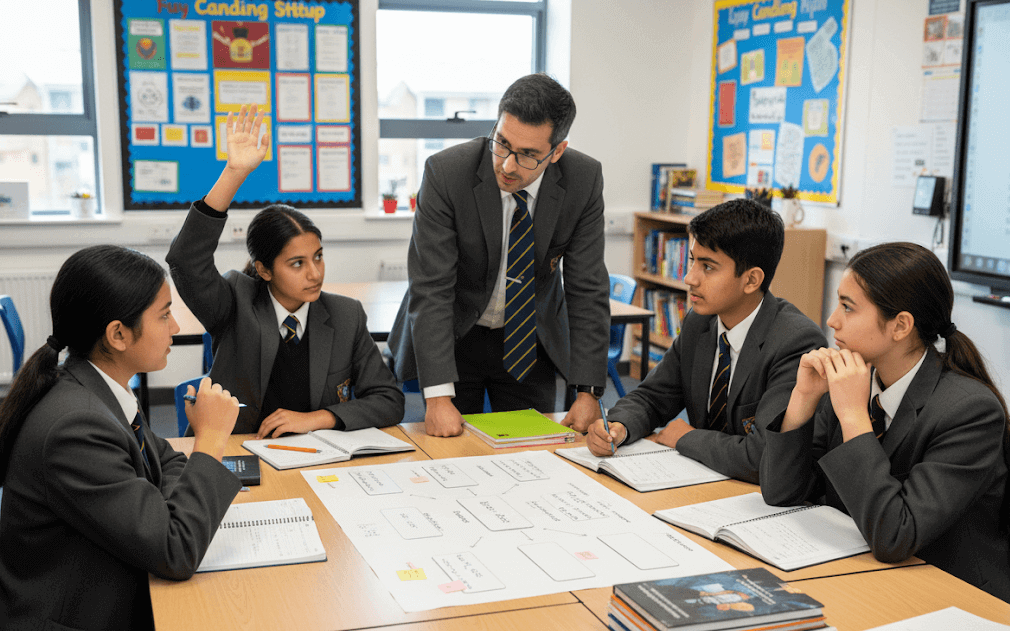

Master effective classroom questioning techniques with our guide, designed to engage students and stimulate critical thinking.
Teachers in 2025 face a persistent challenge. They ask questions but rarely use them to stretch student thinking. Questions often fail to engage because they stay at surface level. The gap between checking facts and fostering deep understanding remains wide.
Teacher questioning refers to the deliberate use of questions to assess understanding, promote thinking, and guide learning. Too many classroom questions focus on recall. They check if students remember information rather than whether they can apply, analyze, or evaluate it.
Bloom's taxonomy of cognitive skills provides a useful framework. The revised taxonomy identifies six levels of cognitive learning. Each level requires different thinking processes. Classification taxonomies have evolved to guide teacher questioning, from early work by Krathwohl (1964) and Wilen (1986) to Morgan and Saxton (1991). Hannel and Hannel (2005) demonstrated how teacher questions promote student engagement. Dekker-Groen (2015) examined how sequences of teacher and student questions influence classroom dialogue.
These frameworks help, but they need careful application. Each classroom situation is unique. Not every student needs questions at multiple cognitive levels in every lesson.
Schons's (1983) model of reflection offers three critical questions for teachers:
Being able to categorize questions is a starting point for improving practice.
Questions are integral to classroom life. They form a core part of every teacher's pedagogical repertoire. Yet they often serve merely to check facts. Black et al. (2003) stated that higher-order probing questions enable teachers to be better informed about student progress. This knowledge leads to more individualized and differentiated support. Questions that probe for deeper meaning foster critical thinking skills. They encourage the flexible learners and problem-solvers needed in modern classrooms.

Questioning forces students to think critically about content. When teachers ask questions, students must process information and generate solutions. They cannot rely on memorized responses.
Teacher questions function as feedback mechanisms. Feedback allows teachers to determine whether their methods work. This matters particularly in subjects like mathematics, where problems can be solved through trial and error. Rather than simply providing correct answers, teachers should offer multiple choices and let students determine which solution works.
This approach is called open-ended questioning. It requires students to use critical thinking and problem-solving abilities. Open-ended questioning appears across science, social studies, and language arts lessons.
Creating effective cognitive questions is simpler than it sounds. Some classrooms display question walls as reference points for quick thinking. A question matrix can help generate divergent questions both in the moment and during planning.
The Thinking Framework thinking skills cards provide a practical tool for generating questions on the spot. These 30 cards are organized into five colored categories: Green (Extract...), Blue (Categorise...), Yellow (Explain...), Orange (Target Vocabulary...), and Red (Combine...). Each card prompts a specific type of cognitive response. Teachers can select a card that matches their learning objective and use it to frame questions during a lesson. Students can also use these cards to generate questions for peers, turning questioning into a collaborative learning activity rather than a teacher-led exercise.
The key to eliciting comprehensive student responses is focusing on questions from the bottom right corner of a cognitive matrix. Questions beginning with "Why did...?" or "How might...?" produce answers requiring detailed explanation. Complex questions demand more student thinking than simple yes-no responses.
Tom Sherrington recently argued that depth of knowledge shows in the ability to explain something. This type of deep learning emerges through sophisticated student responses. These responses are nurtured and articulated through well-designed cognitive questions.
Within the Thinking Framework, Socratic questioning is categorized according to desired learning outcomes. Teachers think about the learning experience and consider how they want learners to think. The cognitive response you want to nurture determines the way you talk about content.
This dialogic approach describes learning through talk, not learning to talk. The Thinking Framework includes response structures that equip teachers with talking stems. These make the approach easier to facilitate. We call it planning for understanding. The student responses we cultivate enable children to put thoughts into words. These methods act as springboards toward better writing.
Creating classroom cultures of deep learning requires adequate thinking time. We slow the process down. We cause more deliberate and meaningful cognitive responses.
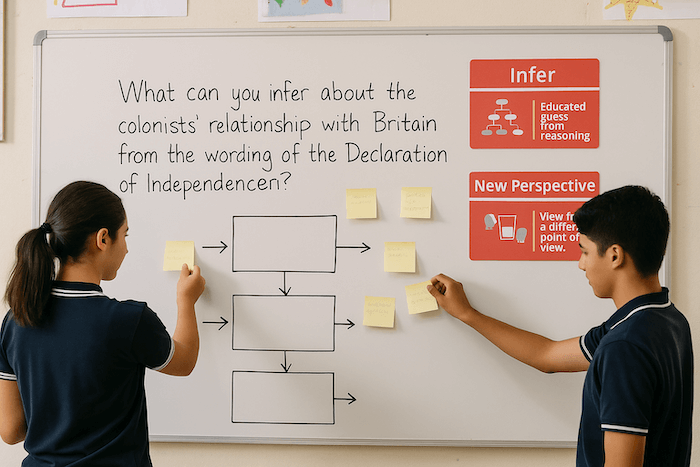
Questioning serves many purposes. When used effectively, it engages students and provides opportunities for them to ask their own questions. Too often teachers pose questions and wait for responses. They forget to pause, allowing students to think. They forget to pounce, targeting questions to learners based on ability and understanding. They forget to bounce, directing the question to another learner for additional responses and perspectives.
Extending questioning means asking students to compose questions for each other. This works during recaps or within teaching sessions. It challenges levels of thinking. It informs both student and teacher whether students are ready to progress. This simple recap tool uses consolidation and active learning techniques to foster metacognition.
Questioning is a crucial pedagogical skill requiring practiced application (Cavanaugh and Warwick, 2001). Paramore (2017) identifies an imbalance of questions in teaching. There is a dominance of teacher talk and an over-reliance on closed questions. These questions check learning or verify activities but provide limited assessment for learning.
Questions from teachers are often organizational: "What do we always put at the top of our page?" They are instructional: "Who can tell me what an adjective is?" These questions have low cognitive involvement. They result in limited answers like "Yes" or "No."

Wragg (1993) found teachers commonly use management-related questions such as "Has everyone finished this piece of work?" or information recall questions like "How many sides does a quadrilateral have?" They rarely use higher-order questions such as "What evidence do you have for saying that?"
Open or divergent questions encourage greater expansion in answers. They promote better classroom dialogue and understanding (Tofade, Elsner and Haines, 2013). Teachers often want to move swiftly through content. They deliver knowledge but forget to support students to reflect, consolidate, and make new connections in meaning (Vygotsky 1978).
Students become disengaged with repetitive questioning. This leads to low self-esteem. How often do the same students answer questions? Petty (2014) states that the volunteer approach of hands up fosters disengagement. Teachers get only an overview of how one student thinks. If we want to engage students, generate motivation, and foster problem-solving skills, a more active learning approach is needed.
Lightbody (2011) advocates that questioning is supported by pedagogical content knowledge (Shulman 1986). This involves the teacher being aware of their subject's structure. They identify areas where students struggle. They develop key questions to support understanding. An effective teacher then stretches students through hinge questions ("What do you know about...?") and probe questions ("Tell me why you came to that conclusion?") (Horsman 2020).

Identify and list key questions on planning documents. Questions that explore the what, how, if, or when of a subject help teachers better question students. This supports thinking about questions before the session rather than during it. Scripting questions helps teachers identify key learning areas and ensures all content is assessed.
Boyd (2015) talks about how teachers can support talk and thinking if they listen. They then use questions to support student ideas, purposes, and lines of reasoning. By scripting questions beforehand, key ideas can be explored in detail.
Another useful technique is following one question with "Why do you think that?" or "How did you come to that conclusion?" This double-barreled questioning technique supports flexible thinking.
Low-level questioning aimed at recall plateaus classroom learning quickly. Higher-level questions produce deeper learning and thinking. With higher-order questioning, teachers must have support mechanisms allowing learners to fail. Teachers often use questions that guarantee safe answers. They do not allow students to trial different responses.
Generate a classroom culture where there is no wrong answer. Instead, there are half answers or partial answers that can be collectively completed through multiple student responses. Use simple techniques to support resilience and higher-order thinking.

Wait time remains one of the most powerful yet underused techniques. After asking a question, pause for at least three seconds. This gives all students time to formulate responses. Research shows that extending wait time increases the length and quality of student answers.
The Pause-Pounce-Bounce sequence builds on this. First, pause to allow thinking time. Next, pounce by directing the question to a specific student rather than accepting volunteers. Finally, bounce the question to another student for a different perspective or to build on the first response.
This technique prevents the same eager students from dominating classroom discussion. It keeps all students alert because anyone might be asked. It also demonstrates that questions can have multiple valid responses.
Cold calling means asking a question and then selecting a student to answer, rather than waiting for volunteers. This keeps every student engaged because they know they might be called upon.
Done well, cold calling is not intimidating. You establish a supportive classroom culture first. Students understand that partially formed answers are welcome. They know they can say "I'm not sure yet" and receive help.
Cold calling works particularly well after wait time or think-pair-share. Students have had time to prepare an answer. They feel more confident when called upon. The technique ensures broad participation across the class rather than just from confident volunteers.
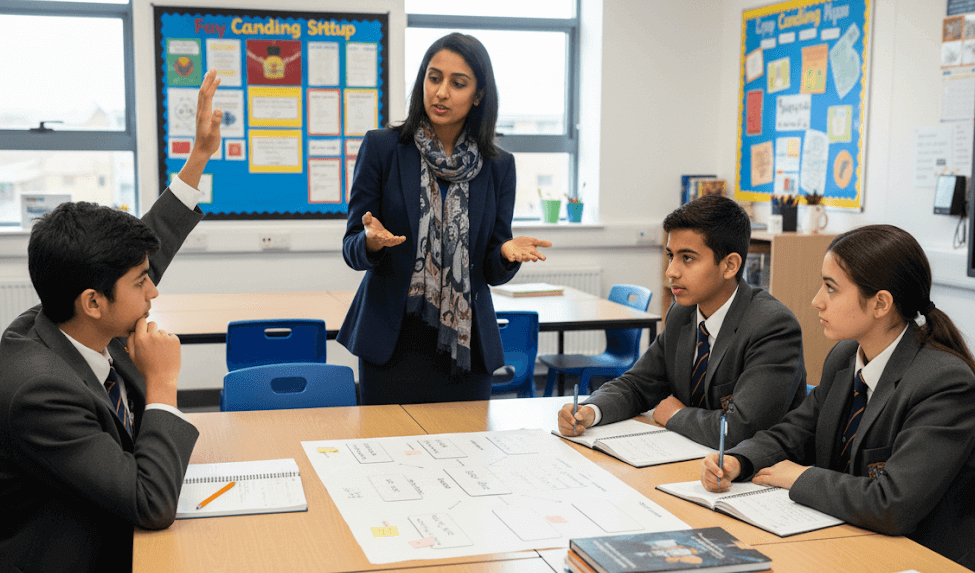
Think-pair-share gives students structured time to develop responses. First, students think individually about a question for a set time. Next, they pair with a neighbor to discuss their ideas. Finally, pairs share their thinking with the whole class.
This technique supports all learners. Quieter students gain confidence from rehearsing ideas with one peer first. Students with incomplete understanding can learn from their partners. The whole class discussion becomes richer because students have refined their thinking.
Think-pair-share works across subjects and age groups. It can be used for quick checks of understanding or for complex problem-solving tasks.
The Socratic method uses sequences of questions to help students discover concepts themselves. Rather than explaining directly, teachers ask guiding questions that lead students toward understanding.
Start with a claim or statement. Ask students what they think about it. Follow up with questions like "What makes you say that?" or "Can you give me an example?" Push deeper with "What would happen if...?" or "How does that connect to...?"
This method takes more time than direct instruction. It develops critical thinking skills and helps students construct their own understanding. The Thinking Framework organizes Socratic questions by cognitive purpose, making this approach easier to plan and implement.

Hinge questions come at critical points in a lesson. They check whether students have grasped a key concept before moving forward. Every student must answer, usually on mini whiteboards or response cards.
A good hinge question has these features:
If most students answer correctly, you proceed. If many struggle, you reteach the concept before continuing. Hinge questions prevent students from falling behind early in a lesson sequence.
Double-barreled questioning means following any answer with a second question. This extends student thinking beyond their first response.
After a student answers, ask:
This technique signals that you value depth over quick responses. Students learn to think more carefully about their initial answers. They develop the habit of justifying their thinking.
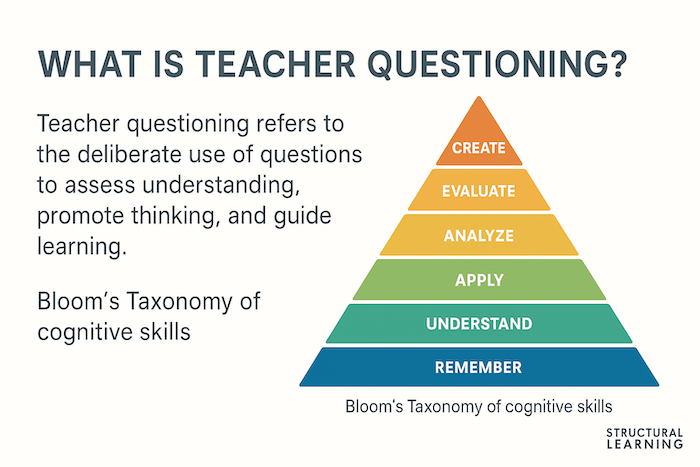
Ask students to create questions about content. This works for recap sessions or as part of active learning. Students must understand material deeply to write good questions about it.
Students can write quiz questions for peers. They can generate questions they still have about a topic. They can create questions they think might appear on an assessment.
This technique reveals what students find important or confusing. It also promotes metacognitive strategies because students must think about what makes a good question.
Phone a friend allows students to direct a difficult question to a classmate for help. This reduces pressure on individual students. It builds a collaborative classroom culture.
When a student receives a challenging question, they can "phone a friend" and ask another student for support. The friend provides hints or partial answers. The original student then completes the response.
This technique acknowledges that we all need help sometimes. It keeps students engaged rather than shutting down when they do not know an answer immediately.

Divergent questions have many possible valid answers. They encourage creative and critical thinking. They contrast with convergent questions, which have one correct answer.
Examples include:
Divergent questions promote classroom discussion. They show students that thinking matters more than memorizing. They encourage risk-taking because multiple answers are acceptable.
A no hands up policy means students cannot volunteer to answer questions. Instead, the teacher selects who responds. This can be done randomly, strategically, or through techniques like cold calling.
This policy ensures broad participation. It prevents the same students from answering every question. It keeps all students alert and thinking.
You need strong classroom relationships for this to work well. Students must feel safe giving incomplete answers. They need to know that struggle is part of learning.

Recaps use questioning to consolidate learning. Students reflect on their learning by summarizing content to peers. This can happen at the end of a lesson or at the start of the next session.
Effective recap approaches include:
Recaps force students to retrieve information from memory. This strengthens learning more effectively than simply reviewing notes. These strategies align with formative assessment principles and promote deeper engagement.
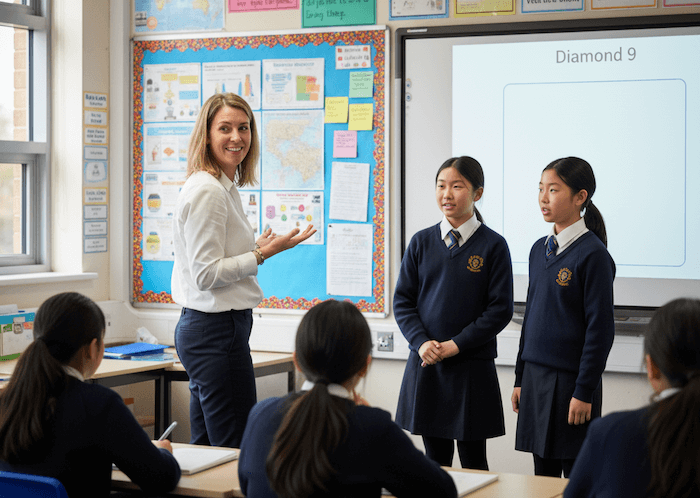
Here are five studies examining the efficacy of questioning in the classroom and how it improves student engagement and outcomes:
Bundick et al. (2014): This study highlights the importance of student-teacher relationships, content relevance, and pedagogical competence in engaging students. It proposes a model for understanding and promoting student engagement through effective questioning and classroom interactions.
Wilen & Clegg (1986): This review identifies eleven questioning practices positively correlated with student achievement, emphasizing the impact of effective questioning on learning outcomes. It highlights the role of direct and assertive questioning in stimulating deeper and complex thinking.
Crooks (1988): The review suggests that classroom evaluation practices, including types of questions and feedback on incorrect answers, have significant impacts on students' learning strategies, motivation, and achievement. It underscores the importance of thoughtful questioning and follow-up questions for effective learning.
Tschannen-Moran & Hoy (2001): Exploring teacher efficacy, this study connects teachers' belief in their questioning skills to student outcomes such as motivation and achievement. It emphasizes the need for confident teachers who can engage students through assertive and effective questioning.
Oga-Baldwin (2019): Focusing on foreign language learning, this review discusses how engagement through various types of questions, including open-ended and choice of answers, can enhance the learning process and improve mastery and visual learning outcomes.
These studies collectively demonstrate the significant role of questioning in the classroom, emphasizing how different types of questions can facilitate learning processes, deepen student understanding, and ultimately improve academic outcomes.
Teachers in 2025 face a persistent challenge. They ask questions but rarely use them to stretch student thinking. Questions often fail to engage because they stay at surface level. The gap between checking facts and fostering deep understanding remains wide.
Teacher questioning refers to the deliberate use of questions to assess understanding, promote thinking, and guide learning. Too many classroom questions focus on recall. They check if students remember information rather than whether they can apply, analyze, or evaluate it.
Bloom's taxonomy of cognitive skills provides a useful framework. The revised taxonomy identifies six levels of cognitive learning. Each level requires different thinking processes. Classification taxonomies have evolved to guide teacher questioning, from early work by Krathwohl (1964) and Wilen (1986) to Morgan and Saxton (1991). Hannel and Hannel (2005) demonstrated how teacher questions promote student engagement. Dekker-Groen (2015) examined how sequences of teacher and student questions influence classroom dialogue.
These frameworks help, but they need careful application. Each classroom situation is unique. Not every student needs questions at multiple cognitive levels in every lesson.
Schons's (1983) model of reflection offers three critical questions for teachers:
Being able to categorize questions is a starting point for improving practice.
Questions are integral to classroom life. They form a core part of every teacher's pedagogical repertoire. Yet they often serve merely to check facts. Black et al. (2003) stated that higher-order probing questions enable teachers to be better informed about student progress. This knowledge leads to more individualized and differentiated support. Questions that probe for deeper meaning foster critical thinking skills. They encourage the flexible learners and problem-solvers needed in modern classrooms.

Questioning forces students to think critically about content. When teachers ask questions, students must process information and generate solutions. They cannot rely on memorized responses.
Teacher questions function as feedback mechanisms. Feedback allows teachers to determine whether their methods work. This matters particularly in subjects like mathematics, where problems can be solved through trial and error. Rather than simply providing correct answers, teachers should offer multiple choices and let students determine which solution works.
This approach is called open-ended questioning. It requires students to use critical thinking and problem-solving abilities. Open-ended questioning appears across science, social studies, and language arts lessons.
Creating effective cognitive questions is simpler than it sounds. Some classrooms display question walls as reference points for quick thinking. A question matrix can help generate divergent questions both in the moment and during planning.
The Thinking Framework thinking skills cards provide a practical tool for generating questions on the spot. These 30 cards are organized into five colored categories: Green (Extract...), Blue (Categorise...), Yellow (Explain...), Orange (Target Vocabulary...), and Red (Combine...). Each card prompts a specific type of cognitive response. Teachers can select a card that matches their learning objective and use it to frame questions during a lesson. Students can also use these cards to generate questions for peers, turning questioning into a collaborative learning activity rather than a teacher-led exercise.
The key to eliciting comprehensive student responses is focusing on questions from the bottom right corner of a cognitive matrix. Questions beginning with "Why did...?" or "How might...?" produce answers requiring detailed explanation. Complex questions demand more student thinking than simple yes-no responses.
Tom Sherrington recently argued that depth of knowledge shows in the ability to explain something. This type of deep learning emerges through sophisticated student responses. These responses are nurtured and articulated through well-designed cognitive questions.
Within the Thinking Framework, Socratic questioning is categorized according to desired learning outcomes. Teachers think about the learning experience and consider how they want learners to think. The cognitive response you want to nurture determines the way you talk about content.
This dialogic approach describes learning through talk, not learning to talk. The Thinking Framework includes response structures that equip teachers with talking stems. These make the approach easier to facilitate. We call it planning for understanding. The student responses we cultivate enable children to put thoughts into words. These methods act as springboards toward better writing.
Creating classroom cultures of deep learning requires adequate thinking time. We slow the process down. We cause more deliberate and meaningful cognitive responses.

Questioning serves many purposes. When used effectively, it engages students and provides opportunities for them to ask their own questions. Too often teachers pose questions and wait for responses. They forget to pause, allowing students to think. They forget to pounce, targeting questions to learners based on ability and understanding. They forget to bounce, directing the question to another learner for additional responses and perspectives.
Extending questioning means asking students to compose questions for each other. This works during recaps or within teaching sessions. It challenges levels of thinking. It informs both student and teacher whether students are ready to progress. This simple recap tool uses consolidation and active learning techniques to foster metacognition.
Questioning is a crucial pedagogical skill requiring practiced application (Cavanaugh and Warwick, 2001). Paramore (2017) identifies an imbalance of questions in teaching. There is a dominance of teacher talk and an over-reliance on closed questions. These questions check learning or verify activities but provide limited assessment for learning.
Questions from teachers are often organizational: "What do we always put at the top of our page?" They are instructional: "Who can tell me what an adjective is?" These questions have low cognitive involvement. They result in limited answers like "Yes" or "No."

Wragg (1993) found teachers commonly use management-related questions such as "Has everyone finished this piece of work?" or information recall questions like "How many sides does a quadrilateral have?" They rarely use higher-order questions such as "What evidence do you have for saying that?"
Open or divergent questions encourage greater expansion in answers. They promote better classroom dialogue and understanding (Tofade, Elsner and Haines, 2013). Teachers often want to move swiftly through content. They deliver knowledge but forget to support students to reflect, consolidate, and make new connections in meaning (Vygotsky 1978).
Students become disengaged with repetitive questioning. This leads to low self-esteem. How often do the same students answer questions? Petty (2014) states that the volunteer approach of hands up fosters disengagement. Teachers get only an overview of how one student thinks. If we want to engage students, generate motivation, and foster problem-solving skills, a more active learning approach is needed.
Lightbody (2011) advocates that questioning is supported by pedagogical content knowledge (Shulman 1986). This involves the teacher being aware of their subject's structure. They identify areas where students struggle. They develop key questions to support understanding. An effective teacher then stretches students through hinge questions ("What do you know about...?") and probe questions ("Tell me why you came to that conclusion?") (Horsman 2020).

Identify and list key questions on planning documents. Questions that explore the what, how, if, or when of a subject help teachers better question students. This supports thinking about questions before the session rather than during it. Scripting questions helps teachers identify key learning areas and ensures all content is assessed.
Boyd (2015) talks about how teachers can support talk and thinking if they listen. They then use questions to support student ideas, purposes, and lines of reasoning. By scripting questions beforehand, key ideas can be explored in detail.
Another useful technique is following one question with "Why do you think that?" or "How did you come to that conclusion?" This double-barreled questioning technique supports flexible thinking.
Low-level questioning aimed at recall plateaus classroom learning quickly. Higher-level questions produce deeper learning and thinking. With higher-order questioning, teachers must have support mechanisms allowing learners to fail. Teachers often use questions that guarantee safe answers. They do not allow students to trial different responses.
Generate a classroom culture where there is no wrong answer. Instead, there are half answers or partial answers that can be collectively completed through multiple student responses. Use simple techniques to support resilience and higher-order thinking.

Wait time remains one of the most powerful yet underused techniques. After asking a question, pause for at least three seconds. This gives all students time to formulate responses. Research shows that extending wait time increases the length and quality of student answers.
The Pause-Pounce-Bounce sequence builds on this. First, pause to allow thinking time. Next, pounce by directing the question to a specific student rather than accepting volunteers. Finally, bounce the question to another student for a different perspective or to build on the first response.
This technique prevents the same eager students from dominating classroom discussion. It keeps all students alert because anyone might be asked. It also demonstrates that questions can have multiple valid responses.
Cold calling means asking a question and then selecting a student to answer, rather than waiting for volunteers. This keeps every student engaged because they know they might be called upon.
Done well, cold calling is not intimidating. You establish a supportive classroom culture first. Students understand that partially formed answers are welcome. They know they can say "I'm not sure yet" and receive help.
Cold calling works particularly well after wait time or think-pair-share. Students have had time to prepare an answer. They feel more confident when called upon. The technique ensures broad participation across the class rather than just from confident volunteers.

Think-pair-share gives students structured time to develop responses. First, students think individually about a question for a set time. Next, they pair with a neighbor to discuss their ideas. Finally, pairs share their thinking with the whole class.
This technique supports all learners. Quieter students gain confidence from rehearsing ideas with one peer first. Students with incomplete understanding can learn from their partners. The whole class discussion becomes richer because students have refined their thinking.
Think-pair-share works across subjects and age groups. It can be used for quick checks of understanding or for complex problem-solving tasks.
The Socratic method uses sequences of questions to help students discover concepts themselves. Rather than explaining directly, teachers ask guiding questions that lead students toward understanding.
Start with a claim or statement. Ask students what they think about it. Follow up with questions like "What makes you say that?" or "Can you give me an example?" Push deeper with "What would happen if...?" or "How does that connect to...?"
This method takes more time than direct instruction. It develops critical thinking skills and helps students construct their own understanding. The Thinking Framework organizes Socratic questions by cognitive purpose, making this approach easier to plan and implement.

Hinge questions come at critical points in a lesson. They check whether students have grasped a key concept before moving forward. Every student must answer, usually on mini whiteboards or response cards.
A good hinge question has these features:
If most students answer correctly, you proceed. If many struggle, you reteach the concept before continuing. Hinge questions prevent students from falling behind early in a lesson sequence.
Double-barreled questioning means following any answer with a second question. This extends student thinking beyond their first response.
After a student answers, ask:
This technique signals that you value depth over quick responses. Students learn to think more carefully about their initial answers. They develop the habit of justifying their thinking.

Ask students to create questions about content. This works for recap sessions or as part of active learning. Students must understand material deeply to write good questions about it.
Students can write quiz questions for peers. They can generate questions they still have about a topic. They can create questions they think might appear on an assessment.
This technique reveals what students find important or confusing. It also promotes metacognitive strategies because students must think about what makes a good question.
Phone a friend allows students to direct a difficult question to a classmate for help. This reduces pressure on individual students. It builds a collaborative classroom culture.
When a student receives a challenging question, they can "phone a friend" and ask another student for support. The friend provides hints or partial answers. The original student then completes the response.
This technique acknowledges that we all need help sometimes. It keeps students engaged rather than shutting down when they do not know an answer immediately.

Divergent questions have many possible valid answers. They encourage creative and critical thinking. They contrast with convergent questions, which have one correct answer.
Examples include:
Divergent questions promote classroom discussion. They show students that thinking matters more than memorizing. They encourage risk-taking because multiple answers are acceptable.
A no hands up policy means students cannot volunteer to answer questions. Instead, the teacher selects who responds. This can be done randomly, strategically, or through techniques like cold calling.
This policy ensures broad participation. It prevents the same students from answering every question. It keeps all students alert and thinking.
You need strong classroom relationships for this to work well. Students must feel safe giving incomplete answers. They need to know that struggle is part of learning.

Recaps use questioning to consolidate learning. Students reflect on their learning by summarizing content to peers. This can happen at the end of a lesson or at the start of the next session.
Effective recap approaches include:
Recaps force students to retrieve information from memory. This strengthens learning more effectively than simply reviewing notes. These strategies align with formative assessment principles and promote deeper engagement.

Here are five studies examining the efficacy of questioning in the classroom and how it improves student engagement and outcomes:
Bundick et al. (2014): This study highlights the importance of student-teacher relationships, content relevance, and pedagogical competence in engaging students. It proposes a model for understanding and promoting student engagement through effective questioning and classroom interactions.
Wilen & Clegg (1986): This review identifies eleven questioning practices positively correlated with student achievement, emphasizing the impact of effective questioning on learning outcomes. It highlights the role of direct and assertive questioning in stimulating deeper and complex thinking.
Crooks (1988): The review suggests that classroom evaluation practices, including types of questions and feedback on incorrect answers, have significant impacts on students' learning strategies, motivation, and achievement. It underscores the importance of thoughtful questioning and follow-up questions for effective learning.
Tschannen-Moran & Hoy (2001): Exploring teacher efficacy, this study connects teachers' belief in their questioning skills to student outcomes such as motivation and achievement. It emphasizes the need for confident teachers who can engage students through assertive and effective questioning.
Oga-Baldwin (2019): Focusing on foreign language learning, this review discusses how engagement through various types of questions, including open-ended and choice of answers, can enhance the learning process and improve mastery and visual learning outcomes.
These studies collectively demonstrate the significant role of questioning in the classroom, emphasizing how different types of questions can facilitate learning processes, deepen student understanding, and ultimately improve academic outcomes.